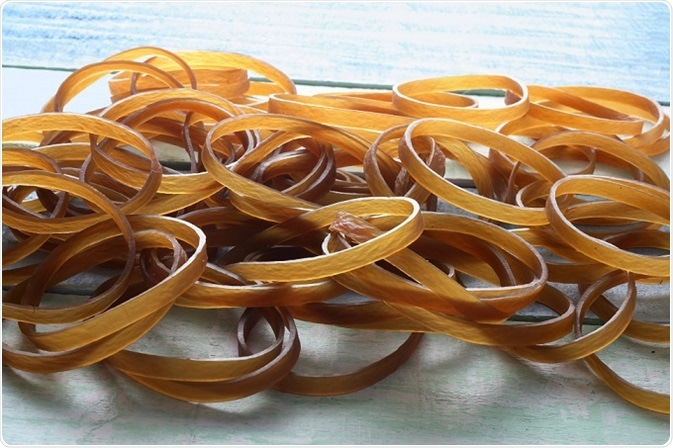
© photosync/shutterstock.com
Elastomers, such as a rubber band, are polymers with elastic properties that enable them to be significantly deformed with minimal force. When the stress is released, the original shape is restored. This ability requires sufficient molecular mobility to allow the distortion whilst maintaining the covalent cross-links to pull the polymer back into its resting position.
Increasing the cross-linking density makes the polymer more difficult to distort, but also makes it more likely to fracture since it reduces the conformational flexibility. The use of ionic interactions has been shown to strengthen elastomers without reducing their robustness1. Furthermore, such ionic bonding is not permanent and irreversible like covalent bonding, and this makes the polymers easier to recycle.
Elastomeric ionomers, by virtue of their unique physical and processing properties, have thus become important commercial polymers. Typically, the ionomers comprise a low level of ionic inorganic salt groups, such as carboxyl, attached to a non-polar polymer chain. In order to neutralise the charge, they usually aggregate into complexes with metal cations. The polymer segments closest to the ionic groups are firmly attached by the strong electrostatic interactions, but greater chain mobility is achieved further away.
Despite numerous investigations into the structure of these ionic aggregate, using a range of techniques, such as X-ray scattering, transmission electron microscopy and dynamic mechanical analysis, it is still not fully understood how they achieve such exceptional elastic properties2,3. Their unique scientific characteristics have thus remained an ongoing source of intrigue.
With the increasing popularity of low-field time-domain nuclear magnetic resonance (NMR) and its proven capabilities as a versatile and powerful analytical tool, it has been identified as a possible novel strategy for gaining more knowledge about the network structure and chain dynamics of elastomeric ionomers.
Nuclear magnetic resonance
NMR spectroscopy has long been recognised as a powerful analytical tool for obtaining detailed structural information. With the explosion of innovation in analytical methodologies using NMR spectroscopy, the potential of the much simpler, and less expensive, related technique — time domain NMR—has been overlooked for many years.
NMR spectroscopy uses a strong magnetic field to excite nuclei to a higher energy level. Subsequent removal of the magnetic field causes the nuclei to return to their base energy level. In doing so, the energy they had absorbed is released. The radiofrequency of the energy released creates characteristic spectra, which can be used to obtain a high level of detail and spatial resolution about complex molecules and their environment.
Rather than measuring the amount of energy released, time domain NMR measures the time required for nuclei to return to equilibrium after excitation. This can be achieved with compact, low-field NMR spectrometers and the results interpreted without an in-depth knowledge of chemistry and physics.
Although Time domain NMR does not provide the same level of atomic or spatial resolution as NMR spectroscopy, compared with NMR spectroscopy, time domain NMR has the added advantages of being simple to execute, portable and more affordable.
Analysis of structure of elastomeric ionomers
There has been much interest in determining the precise structure of the heterogeneous elastomeric ionomers in order to help understand how their unique properties are achieved. However, their hierarchical structure and dynamic ionic interactions have made this particularly challenging and time consuming.
A new level of structural detail was achieved by using a combination of different advanced time-domain NMR strategies4. The measurements were all obtained using the affordable and easy-to-use low-field Bruker Minispec mq20 spectrometer. Researchers were able to investigate the network structure and chain dynamics of ionic elastomers and how they changed across different temperature ranges.
The ionic elastomer studied was based on carboxylated nitrile rubber cross-linked with different levels of magnesium oxide. It was revealed that addition of magnesium oxide increased the strength of the elastomer by creating a larger number of smaller ionic clusters, which allowed dynamic cross-linking. These clusters had not previously been observed using other analytical techniques. This clustering resulted in a decrease in the distances between the ionic moieties, which increased aggregation and allowed stronger ionic interactions. Increases in temperature resulted in changes in the ionic rearrangement dynamics, which make it possible to melt-process ionic elastomers under low-shear conditions.
Thus, new structural features of ionic elastomers, which help explain the unusual physical characteristics of these polymers, have been identified using a simple benchtop spectrometer.
References
- Holden G, et al. Thermoplastic Elastomers. Carl Hanser Verlag. Munich, Germany, 2004.
- Dalmas F and Leroy E. Macromolecules 2011, 44 (20), 8093−8099.
- Van der Mee MAJ, et al. Macromolecules 2008, 41, 5493−5501.
- Malmierca MA, et al. Characterization of Network Structure and Chain Dynamics of Elastomeric Ionomers by Means of 1H Low-Field NMR. Macromolecules 2014, 47, 5655−5667.
About Bruker BioSpin - NMR, EPR and Imaging

Bruker BioSpin offers the world's most comprehensive range of NMR and EPR spectroscopy and preclinical research tools. Bruker BioSpin develops, manufactures and supplies technology to research establishments, commercial enterprises and multi-national corporations across countless industries and fields of expertise.
Sponsored Content Policy: News-Medical.net publishes articles and related content that may be derived from sources where we have existing commercial relationships, provided such content adds value to the core editorial ethos of News-Medical.Net which is to educate and inform site visitors interested in medical research, science, medical devices and treatments.